R Peter Bloor - Memories of Stanfields Tech. 1953-1960
Looking back it is surprising what one can still remember of even the most mundane events of time at Stanfields Tech. In September of this year, 2013, it will be sixty years since I first passed through its gates. I must admit that browsing through this website did help to jog the memory. Here’s my contribution….
Members of Staff.
Almost without exception teachers were knowledgeable in their subject, were very approachable, had a sense of humour and were “characters”. Discipline was generally strict. Some staff, having just left a life in the Armed Forces during WWII, brought with them the discipline they experienced there into the classroom.
Mr (Geog) Taylor (Geography) occupied the classroom above the main hall at Moorland Road. He was a very friendly, likeable, “grand-dad” character. As a sideline to his teaching he owned a shop in London Road, Stoke in which he sold amongst other things, photographic items and magic tricks. He was a member of the Magic Circle. Little encouragement was needed to get him to perform some of his tricks during lessons or sell you a magic trick or a packet of foreign stamps. All this helped to supplement his teacher’s meagre salary!
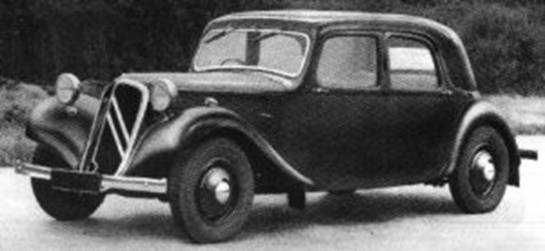 In the 1950’s foreign cars were not all that common on
English roads so heads turned when Geog Taylor arrived at school driving
a Citroën Big 6H. It was a vehicle fitted with the revolutionary hydro - pneumatic
suspension and was a car made famous at that time in the popular TV series “Maigret“.
In the 1950’s foreign cars were not all that common on
English roads so heads turned when Geog Taylor arrived at school driving
a Citroën Big 6H. It was a vehicle fitted with the revolutionary hydro - pneumatic
suspension and was a car made famous at that time in the popular TV series “Maigret“.
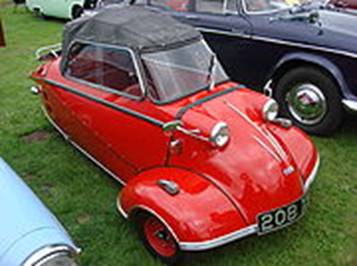 Even more heads turned when Mr (Jim) Edwards (Applied
Maths/ Mechanics) arrived at school in a Messerschmitt Kabinenroller Bubble
Car. It was a bold choice of marque, bearing in mind that less than ten years earlier
British Spitfire Fighter pilots had been shooting down Messerschmitts during WWII.
And when Jim hinged up the cockpit roof and climbed out of the car the image
of a Messerschmitt Me109 fighter aircraft was complete! It must be said that in
the 1950’s, at the height of severe petrol shortages, bubble cars like this
became quite a popular mode of affordable transport.
Even more heads turned when Mr (Jim) Edwards (Applied
Maths/ Mechanics) arrived at school in a Messerschmitt Kabinenroller Bubble
Car. It was a bold choice of marque, bearing in mind that less than ten years earlier
British Spitfire Fighter pilots had been shooting down Messerschmitts during WWII.
And when Jim hinged up the cockpit roof and climbed out of the car the image
of a Messerschmitt Me109 fighter aircraft was complete! It must be said that in
the 1950’s, at the height of severe petrol shortages, bubble cars like this
became quite a popular mode of affordable transport.
Jim Edwards was a strict disciplinarian and put the fear of God in his pupils.
The pictures here were sourced from the internet to depict the models types referred to.
Another motoring story concerned Mr (Tracker) (Technical Drawing) Howell’s car - the story being that his car was an ex Motor Show Exhibit and that under the bonnet the engine and all the other bits and pieces were all chromium plated. Mr Howell helped to run the Hobbies Club, one of my favourite school clubs.
Many staff used particular turns of phrase. Mr (Pansy) Mountford (English) I recall used to shout “Cut it out, Cut it out “ if someone misbehaved in class (as they very often did). I also remember a comment he made on one of my English Essays. I had included in it a French phrase and wrote “(excuse my French)”. When he returned my essay after marking it he had written at the bottom. “I also excuse your English”. He was a keen philatelist and ran the popular weekly Stamp club.
Harry (Bees-knees) Taylor (Woodwork) used the term Bees - knees to describe anything that was first class. He was a perfectionist, and expected the same of his pupils. If you cut a joint that was not a precise fit he would say “A blind man on a galloping horse will never notice”. He also had the annoying habit of borrowing your pencil and afterwards putting it in his own top pocket. He usually had gained quite a collection by the end of the lesson.
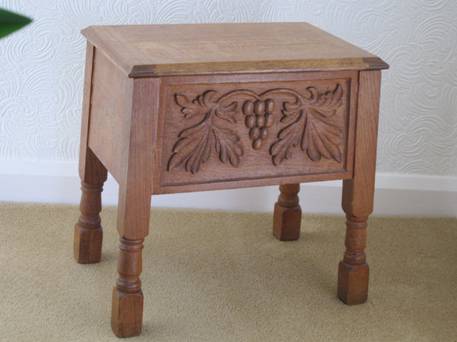 One of his party tricks was to sharpen
a pencil with his razor-sharp AXE! Every tool in his workshop was razor sharp –
rightly, he said that sharp tools were safe tools. He was a true
craftsman and inspired many (including me) to follow him into the teaching
profession. Remember making the teapot stand, a marble arch, a teacloth holder
which incorporated the clever use of a glass marble, and the pencil box with a
sliding lid?
One of his party tricks was to sharpen
a pencil with his razor-sharp AXE! Every tool in his workshop was razor sharp –
rightly, he said that sharp tools were safe tools. He was a true
craftsman and inspired many (including me) to follow him into the teaching
profession. Remember making the teapot stand, a marble arch, a teacloth holder
which incorporated the clever use of a glass marble, and the pencil box with a
sliding lid?
We were introduced to making our first dovetail joints by making a trinket/jewellery box. I modified mine by adding feet and incorporating a musical box movement.
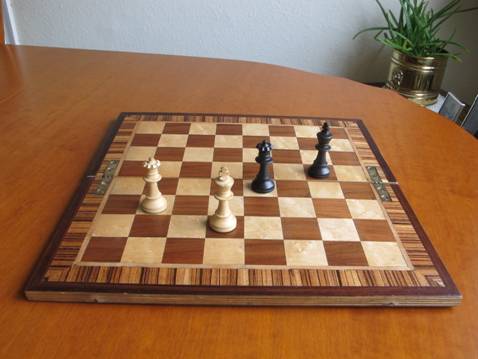 As part of my A level Woodwork course when in the Lower 6th
(in 1959) I made a Jacobean style carved sewing box/stool with a hinged
top. It was made out of Japanese Oak and it’s still in use today.
As part of my A level Woodwork course when in the Lower 6th
(in 1959) I made a Jacobean style carved sewing box/stool with a hinged
top. It was made out of Japanese Oak and it’s still in use today.
Another item I made was a folding veneered chessboard. The playing squares were made of English Walnut and Sycamore while the borders were Maple, cross-banding of Striped Zebrano and Rosewood.
Even the most skilful and careful of persons sometimes suffer serious accidents and this happened to Harry when he lost the ends of his fingers when momentarily distracted whilst using the planer/thicknesser machine.
Mr (Boris) Simnett (English) was a fine teacher but did not suffer fools gladly and if one gave a wrong answer in class he was quite likely to put you down by saying “Here lad, here’s sixpence. Go up to the shop and get me five Woodbines while I talk to the intelligent ones”. I remember his son coming to give a talk to the Hobbies Club on “Caving” and I was particularly intrigued by the acetylene lamp he brought along.
Another fine teacher was Mr Eddie (Dan) Thomas. The first time he took you for mathematics, the homework would be to find out what his “Forget-me-nots” were. I am sure all former students will still remember they were his special version of “Lines”. For him you did not write out 100 times “I must not forget my homework”. You wrote 25 times “The cultivation of an efficient memory is an essential factor in the educational development of every technical student”. He also supplemented his lessons by what he called “book learning”. For anyone not attending he would march up to them armed with his maths textbook “Durell - Part 2”, which he would bring down sharply on their head!
Mr (Bertie) Mills (Physics) was another likeable; “grand-dad” character. He had a penchant for growing Potash Alum crystals in his laboratory. He suspended a seed crystal from a length of string into a vessel containing a saturated solution of the chemical and he had a whole row of these set up on the bench along one side of his laboratory. After a considerable length of time the crystal gradually grew larger in size and into a perfect crystalline form. Bertie is also is remembered for playing tunes by blowing across the end of a bicycle tyre pump and using the sliding action of the handle, trombone style, to achieve the various notes!
I also remember some of the interesting Saturday morning educational visits organised by Mr (JEB) Baileff (Chemistry). These included visits to Shelton Bar Iron & Steel Works at Etruria, a chemical works near Westport Lake which made Nitric Acid and going down Sneyd Colliery which was just above the school in Moorland Road. Just over ten years earlier, on New Year’s Day, 1942, there was a tragic mining disaster here in which 57 miners lost their lives. All these industrial sites have now disappeared.
Mr (Fifi) Taylor (History) organised annual school day trips. I recall going by rail to London and another year, again by train, going to Windermere/Ambleside and Morecambe. His history room was the venue for the Jazz Club meetings. Here members listened to jazz records or created their own music. Classmate Geoffrey Davies, I recall, was a dab hand on his homemade Double Bass made out of a Tea Chest! I didn’t play an instrument but I did attempt to record the efforts of the others on the school wire sound recorder. The recording medium was a very fine steel wire which passed over the recording head at an alarmingly high speed. It was very prone to going wrong, frequently resulting in miles of wire flying across the room. I later acquired my own reel to reel tape recorder and took it to these sessions and used it with a greater degree of success. I also recorded the Carol Concerts which were held in the newly opened St. Werburg’s Church. Sadly none of these recordings have survived.
Mr (Jack) Berrisford (Technical Drawing) had his drawing office on the very top floor of the Moorland Road building. His insistence on precise order and rules verged on the obsessive. Before lining up outside his room for the lesson, pupils were expected to have visited the cloakroom and run cold water over their wrists for a couple of minutes. This we were told was to prevent our hands from sweating and thus putting finger marks on our drawing paper! At the end of the lesson there was a meticulous inspection by Mr Berrisford of our drawing desks - every piece of drawing equipment had to be precisely placed to a set pattern on the drawing board and every last pencil erasure rubbing must have been swept from the drawing desk or one was reprimanded.
Mr Arthur (Charlie) George. (Metalwork). His domain was the fitting shop across the yard from the main building at Moorland Road which in former times had been the hospital mortuary. Here pupils had their first taste of metalwork by making the famous Ash Scraper, tap wrench and then the poker forged in the adjacent blacksmith’s forge. When I first met Mr George in 1953 we were both “new boys” in the school, but in fact he had himself been a pupil here in 1939. On leaving the school, then known as the Junior Technical School, and after a stint in the Armed forces and in teacher training, he returned as a member of staff in 1952 or ‘53. He was a keen photographer and used these skills to record his extensive tours across the length and breadth of Europe, which he undertook every summer holiday. He was also a tireless supporter of his local Church. He died in February 2012, aged 87.
Mr David (Osram) Light joined the staff when the new Art room was built at Stanfields in the mid 1950’s. As well as his undoubted artistic skills, his musical talents were put to good use as the school choirmaster. I was a member of the school choir and fondly remember the Carol Concerts held at the newly opened St. Werburg’s Church and our performances at the annual Prize Distribution ceremonies held at the Queen’s Hall, Burslem. I remember one particular piece we sang was a sea shanty called Whip Jamboree and if the audience had listened to the words very carefully they would have heard some rather risqué lyrics!
On a personal note I also remember Mr Light as the person who performed miracles, having made it possible for me and class mate John Edwards to achieve an “O” Level pass in GCE Art having only taken the subject for six months. When he retired David Light used his artistic talents to create a large wall mural in the Potteries Shopping Centre in Hanley.
Works of Art in the Main Hall at Moorland Road
Elsewhere on this website I was pleased to hear that the biblical ceramic tile mural “Suffer little children to come unto me etc.” in Mr (Pansy) Mountford’s room has been rescued. I remember it well, but I remember even more vividly the two very large works of art which hung on the walls of the hall at Moorland Road. I and I guess many others, often spent time each morning, gazing at these pictures while lined up waiting for the arrival of headmaster Mr Bill (Bunny) Potts to conduct the morning assembly.
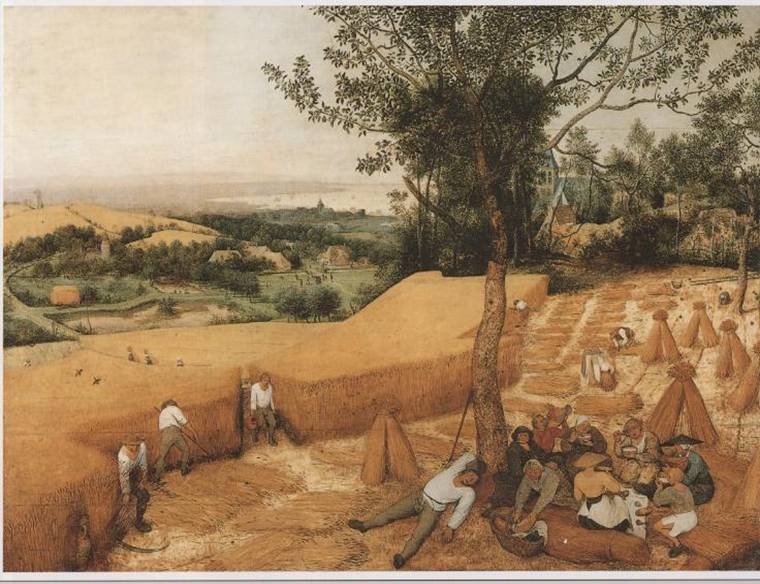 I’ve done a little research on these pictures. The one
shown below, a copy of which hung at the front of the hall by the piano, is
called “The Corn Harvest”. The original was painted by the Dutch artist Pieter
Bruegel in the year 1565 and measured 46.5” x 63.25” and is displayed in the Metropolitan
Museum of Art in New York.
I’ve done a little research on these pictures. The one
shown below, a copy of which hung at the front of the hall by the piano, is
called “The Corn Harvest”. The original was painted by the Dutch artist Pieter
Bruegel in the year 1565 and measured 46.5” x 63.25” and is displayed in the Metropolitan
Museum of Art in New York.
The second picture was on the side wall towards the back of the assembly hall and adjacent to the small cloakroom/PE store. Again it was painted by Bruegel in 1565 and measures 46.5” x 63.25”. It is called “The Hunters in the Snow” and the original is displayed in the Kunsthistorisches Museum in Vienna.
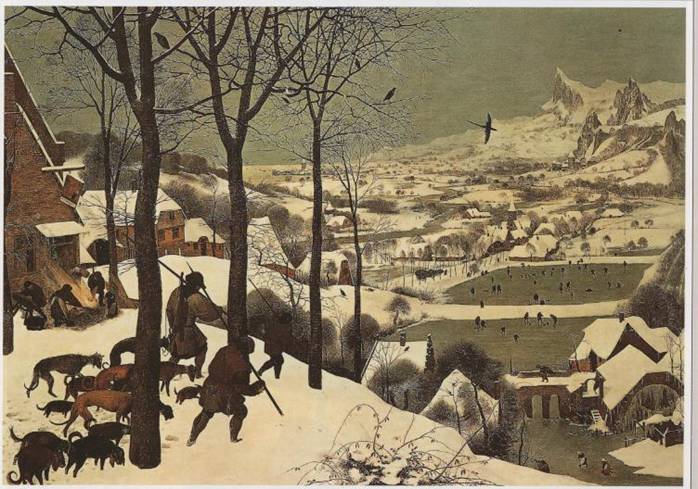
This winter landscape is one of a series of paintings called the Months by Pieter Bruegel, the elder, which were commissioned by Niclaes Jonghelinch, a rich Antwerp banker and a royal official.
Bruegel’s series, which was finished in February 1566, probably consisted of 12 paintings, one for each month of the year, but only 5 now remain. The two paintings shown here represent August and January.
The Buildings at Moorland Road.
I took these three photographs in March 2003. Alongside each one is a description of the usage of the buildings in the 1950’s.
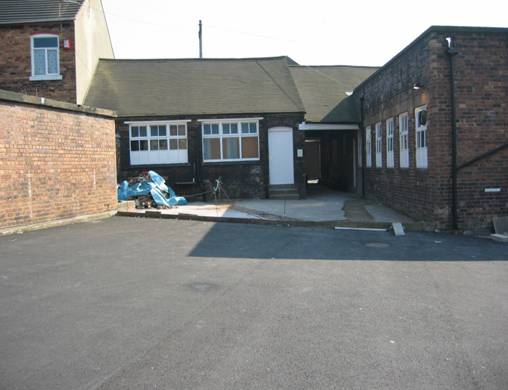 Picture
1 shows Left to Right.
Picture
1 shows Left to Right.
Air Raid Shelter/bicycle shed, Fitting Shop (Mr George), which, in earlier times, had been the hospital mortuary. Remember making here the ash scrapers, engineer’s try-squares, tap wrenches with case-hardened jaws, sliding bevels, pokers (various) and the brass ashtrays?
Centre - the covered area here used to house the Blacksmith’s forge and the doors behind led out into Lingard Street. Far right was the Engineering Workshop. It was always a daunting experience to enter Mr Brownsword’s workshop for the first time. It had an overhead shaft with pulleys, which went the whole length of the workshop and was driven by a large electric motor. Belts came down from these pulleys to power each individual machine. It was a very noisy place and safety guards were pretty much non–existent. To the uninitiated it looked like place waiting for an accident to happen but I don’t recall that one ever did. The place would have been a nightmare for today’s “elf & safety” brigade!
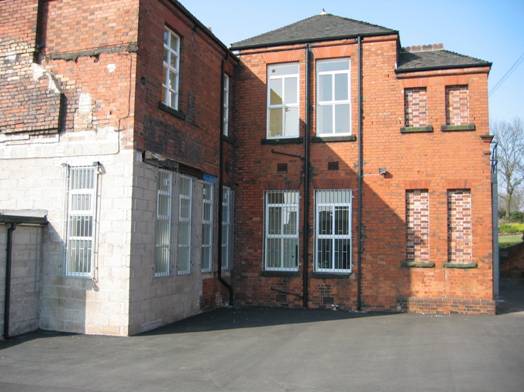 Picture
2.
Picture
2.
This second picture reveals that by 2003, the Chemistry, Physics and Mechanics labs, the outside toilets and the covered walkway leading to them had all been demolished. In earlier days, when the building was the Haywood Hospital, the Chemistry Lab was the Operating theatre.
During the 1953-1960 era, the ground floor room facing the camera would have been the rear of Mr (Flush) Twyfords French room, above it is the rear end of Mr Eddie (Dan) Thomas’s Maths room. The bricked up windows would have been their storerooms. The upper room to the left would have been Mr Tom Goodwin’s very bijou Maths room. The gap to the extreme right was the pupil’s entrance pathway and just showing in the distance across Moorland Road is Burslem Park.
Picture 3.
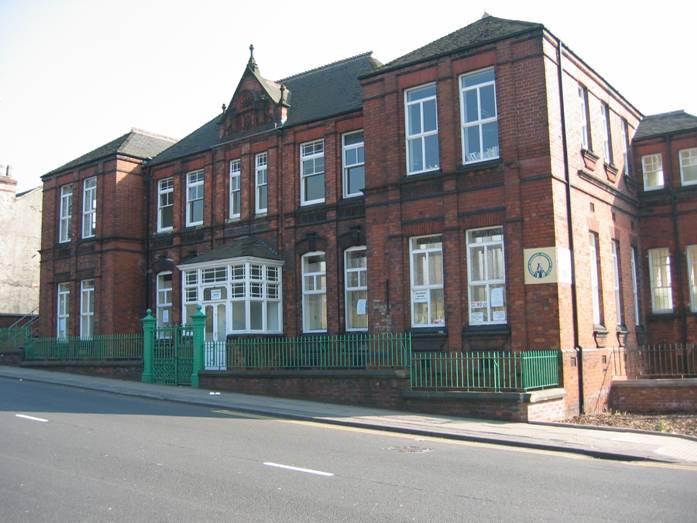 This final picture showing the front elevation.
This final picture showing the front elevation.
Ground floor. Left to Right.
Students pathway to yard, blue fire escape, Mr (Flush) Twyford’s French Room, Main Hall with front porch and entrance (which was rarely used), Mr (Pansy) Mountford’s English room complete with biblical tile mural, and to the extreme right, set back behind a low wall and railings, are the steps leading down to the boiler-house.
Upper floor. Left to Right.
Mr Eddie (Dan) Thomas’s Maths room, Mr (Geog) Taylor’s Geography room, Mr (Boris) Simnett’s English Room.
Looking back, the workshops and many other of the facilities at the Moorland Road Site were really quite primitive and inadequate, there being no cooking facilities for school dinners, the toilets were outside and open to the sky, while the dark, damp Air Raid shelters were used for storing bicycles or for sheltering from the rain at playtime. The main building was a maze of very narrow and steep staircases, with cramped conditions in many of the classrooms. It would have been an absolute nightmare if there had ever been a fire. In spite of all this, everyone soldiered on regardless. Also, with the school operating on two sites at this time (pre September 1960), it often meant students having to walk from Moorland Road to the Stanfields site or vice versa during morning break or at lunchtime, which was an unpopular imposition.
In the early 1950’s the High Lane site consisted of one long narrow white building about 200 yards long. It was built from prefabricated concrete panels slotted into concrete posts/beams – a construction similar to precast concrete garages available today. The rooms were cold, the metal window frames were draughty and the inadequate heating was provided by small electric fan heaters hanging from the roof beams. The building, erected in 1949, was the product of that period of severe austerity immediately after WWII, when economy and rapid construction methods were the order of the day. The main hall served as an assembly hall, gymnasium & dining room. Remember the ex-army wooden folding canteen tables & benches? Another remnant of army life was that at lunchtime, those students who were “on fatigues”, had the task of putting up and stacking away all the folding dining furniture and then sweeping up the mess which was created by others.
Apart from about three general classrooms, the rest of the building was taken up by workshops for woodwork or metalwork, a Drawing Office (Mr (Tracker) Howell) and a brickwork & plumbing workshop. The latter was occupied by Mr (Sam Brick) Ernest. When he wasn’t teaching us to lay bricks, beat sheets of lead into shape or make “wiped” joints on lead pipes, his hobby was breeding and racing whippets. I remember some wag in my class at this time saying that the Dramatic Society was to stage the play “The importance of being Ernest” and they were going to ask him to take part! In later years our relationship reversed when Sam Ernest was appointed to teach for a time in my technical department at a High School in the south of the city.
As numbers on roll increased, new teaching facilities were gradually added to the High Lane site, notably Art and Music rooms and another Drawing Office. Then in 1958 major building work commenced in ernest – sorry to mention him again! Some of my pictures, taken in October 1958, can be found elsewhere on this website showing this building work in progress.
The final departure of the school from the Moorland Road site was in July 1960. During that summer term, and after all the GCE examinations were completed, 5th & VIth formers were roped in to help facilitate the move to Stanfields. The contents of storerooms were sifted through by the teaching staff and items worthy of being retained were packed by students into wooden tea-chests. These were then transported in the “dinner vans” to the High Lane site. The rubbish was piled up in the basement cloakroom for Mr Mountford, the caretaker, to collect and burn in his boiler. I especially remember seeing a mountain of National Geographic Magazines which Geog Taylor had discarded.
I left Stanfields Tech. in July 1960 and so was not around for the official opening of the High Lane site in September of that year, neither was I able to fully appreciate the modern facilities offered by the new buildings. But I would be back!
Postscript - Leaving, but not quite!
My connection with Stanfield County Technical School did not fully come to an end in July 1960. Being sufficiently inspired and impressed by the quality of the teaching I experienced and the skills acquired, I, like many pupils of the school, chose to join the teaching profession. On completion of my teacher training in 1963, I returned to the Stoke on Trent area to teach practical subjects. Coincidentally, my first teaching post was to fill the position in a city school vacated by Mr Don Machin so that he could take up his new teaching post at Stanfields Tech!
At this time, new, existing, and even retired local practical teachers were encouraged by the Handicrafts Organiser for the City at that time, Mr A. E. Bradshaw, to attend Stanfields Tech. for Saturday morning recreational sessions. I accepted the invitation and so in 1963 I was back on familiar ground! Here, under the skilled tuition of old friends Harry Taylor and Arthur George, those who attended were able to expand their knowledge, skills and techniques, using the full range of facilities available in the workshops which were, by far, the best equipped school workshops in Stoke on Trent at that time. We were also encouraged to study for further professional qualifications offered by City & Guilds of London.
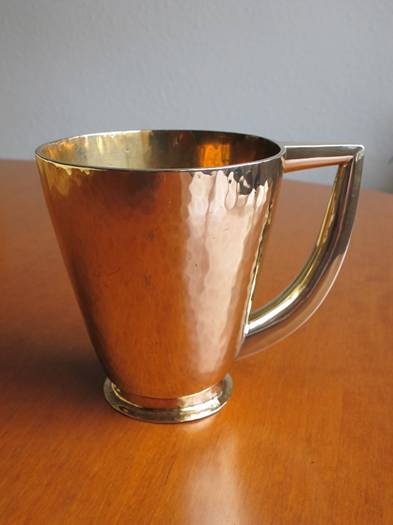 During these sessions we were free to make artefacts for our
own use or make equipment for use in our school workshops. There was always a lively
interchange of ideas and information and know-how between fellow practical
teachers of all ages. Many of the projects we had made as pupils of Taylor
& George, we incorporated into our own Schemes of Work. All this was
particularly useful for me, because in 1964 I was appointed to a newly built
City High school and was responsible for the designing, setting up and
equipping of all the new practical workshops as well as the formulation of
Schemes of Work.
During these sessions we were free to make artefacts for our
own use or make equipment for use in our school workshops. There was always a lively
interchange of ideas and information and know-how between fellow practical
teachers of all ages. Many of the projects we had made as pupils of Taylor
& George, we incorporated into our own Schemes of Work. All this was
particularly useful for me, because in 1964 I was appointed to a newly built
City High school and was responsible for the designing, setting up and
equipping of all the new practical workshops as well as the formulation of
Schemes of Work.
One of my personal projects was a pint tankard. The body started out as a flat twelve inch diameter disc of gilding metal which was gradually hammered up over stakes into the cup shape - there were no joins or seams. The hammering caused the metal to become work hardened, so very frequently the metal needed to be annealed by heating it on the brazing hearth, quenching in water followed by cleaning in an acid bath. The handle was made up of four separately shaped pieces which were silver soldered together. The handle was then silver soldered to the main body. Adding a ring foot completed the job. In total, it took me about twenty Saturday morning sessions of three hours duration to complete – very time consuming and quite a challenge!
I think these Saturday morning sessions continued until about the end of the 1960’s.
As you may have gathered, I enjoyed my 17 years association with Stanfields Tech., and I consider that the knowledge and experience I gained there was an excellent grounding for my adult life.
R. Peter Bloor. May 2013
(SCTS. 1953-1960)